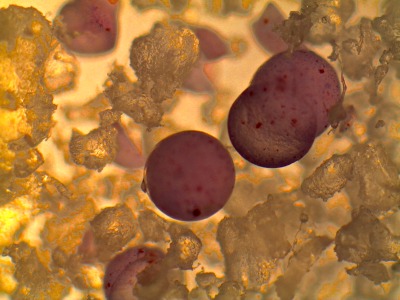May 19, 2015
By Sara Verrillo
You may have heard about recent legislation passed in our state that will ban the production and sale of personal care products containing microbeads – those tiny pieces of plastic that companies use in face and body washes as exfoliators.
Although they may seem like tiny, harmless products, microbeads are a threat to the environment because they pass through wastewater treatment plants and end up polluting our water and harming wildlife.

A picture of microbeads magnified 40x by ACUA Wastewater Lab Director Mike Gille
We’ve heard many people ask – if wastewater treatment plants can remove and treat our sewage, why can’t tiny microbeads be taken care of too?
Microbeads are not filtered out during the wastewater treatment process for a few reasons. To explain them, it is important to first understand how the wastewater treatment process works.
Wastewater Treatment Process
During the first step of the treatment process, large solids are removed from the water through gravity. The flow of water slows down and allows solids to settle to the bottom where they are collected and removed. Light materials like scum and grease float to the top where they are skimmed off.
Any remaining solids are introduced to microorganisms that digest and use the material as food. As these microorganisms grow, they form particles that stick together. They are then moved into a tank where they settle and are eventually removed.
The solids removed during these processes are further dewatered and taken to our incinerator. The water is disinfected to remove any remaining bacteria and enters the Atlantic Ocean.
How Microbeads Get Through
While there is no official guide on dealing with microbeads in the wastewater industry, there are a few things we know about microbeads that we believe gives them the green light through wastewater treatment facilities.
Microbeads are typically made of polyethylene, which is neither light enough to float to the top of water nor heavy enough to sink to the bottom of water. Because of this, they are not removed during the primary treatment settling process.
They are not removed through the secondary treatment process either because (1) they are not a food source for the microorganisms, which means they are not eaten like the other remaining solids; and (2) they are not small enough to be attracted to the charges that the microorganisms put out as they begin to grow, which means they do not become part of the solids that are removed at the end of this step. As a result, microbeads make their way through the treatment plant and into our oceans.
Why It Matters
Microbeads are polluting our waterways and releasing and absorbing harmful toxins that affect marine life and eventually back up the food chain to us. Recent studies of Lake Michigan showed on average, 17,000 bits of tiny plastic items per square kilometer! This is why New Jersey passed legislation against them and many other states are doing the same.
Manufacturers are starting to get the message and companies like
Johnson & Johnson have already committed to phasing out the beads for natural alternatives. In the meantime, avoid purchasing toothpaste, soaps and face washes that contain microbeads to help protect waterways, marine life and human health.